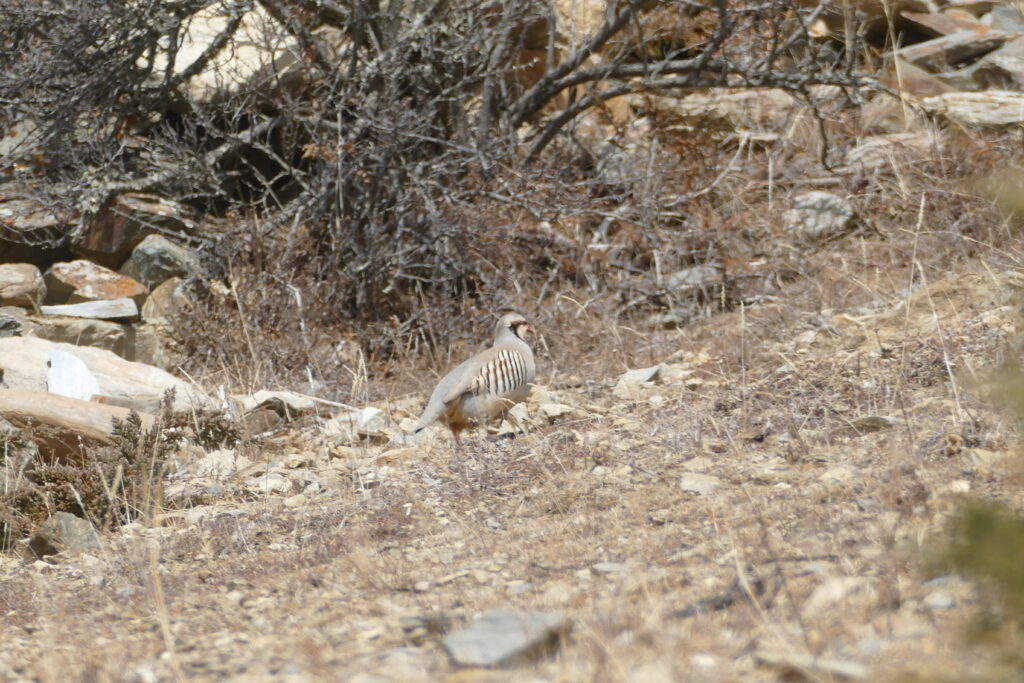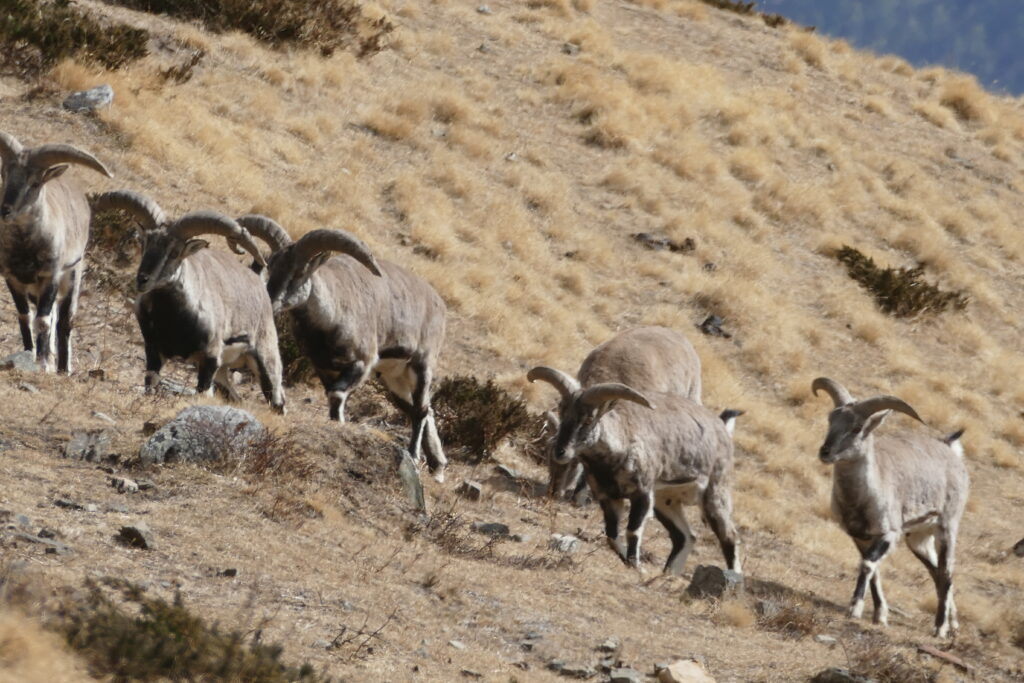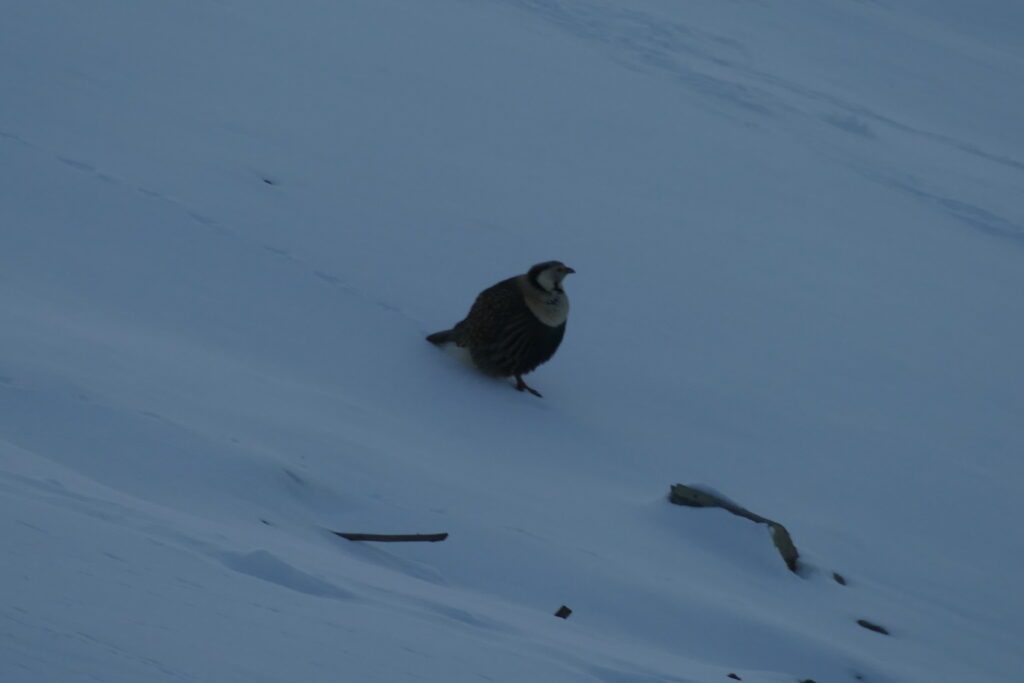It is a relatively warm March evening when our jeep arrives at Dharapani. After a 19-hour-long series of exhilarating bus rides from Kathmandu to Pokhara and from there to Besisahar, where we switched to a jeep to cover the last 40 km, we are relieved to arrive. As we step out of the jeep in Dharapani, a village located within the Annapurna Conservation Area, we are mesmerised by the unearthly beauty of the Annapurna mountain range. We are excited to be here, to spend the next few days hiking the Annapurna Circuit, enjoying a landscape cradled within the Himalayas and observing one of Nepal´s iconic ‘Conservation Areas’ through our ecologist glasses. What we found simply amazed us: remote villages and monasteries showcasing a beautiful intertwining of Hinduism and Buddhism, the shifting landscape from jungle and terrace farmlands through dense alpine forests and rugged slopes to the abode of eternal snow, constantly surrounded by epic views of the Nepalese Himalayas.

A few days earlier in Kathmandu, we meet Dr. Chiran Pokharel, director and department head of the Department of Protected Areas and Conservation Economy at the National Trust for Nature Conservation (NTNC). More than 23% of Nepal’s total area is declared as protected area. This includes 12 national parks, one wildlife reserve, one hunting reserve and six conservation areas. Interestingly however, three out of the six conservation areas are managed by NTNC, an autonomous and not-for-profit organisation in Nepal. Among these is the famous Annapurna Conservation Area, our Himalayan trekking destination for the next 10 days as well as the largest and only self-financed protected area in the country. Therefore we wonder: What are these conservation areas, how is it possible that some of the most famous Himalayan destinations are in the hands of a non-profit, and what does this mean for nature and people?
Where local communities drive conservation
Due to its geography, Nepal is prone to natural disasters and is listed as the 12th most vulnerable country to climate change according to the Global Climate Risk Index 2019. However, the country recognized its susceptibility to ecological risks decades ago, and in the mid 1970s, the government established the first national parks and reserves in biologically rich areas. These early efforts of conservation copied the western system of people versus nature. National parks and reserves were meant to safeguard pristine wilderness from people. Therefore within established protected areas, local communities were relocated and their land use rights were taken away. This led to serious conflicts between people and protected area administrations.
The government of Nepal quickly noticed this, and in response, developed an alternative conservation approach that also takes into consideration the needs of local people. Therefore, in 1982, it created the NTNC, an autonomous entity to complement the government´s nature conservation efforts. Launched four years later, the Annapurna Conservation Area Project (ACAP) became the biggest undertaking of NTNC. Managing the largest protected area of Nepal on the basis of completely independent funding from the government, while fulfilling the requirements of local people and maintaining a balance between nature conservation and sustainable development.
“This is the main difference between national parks and conservation areas. In national parks of Nepal, the army is responsible for law enforcement. In the conservation areas it is the local communities who are in charge,” explains Dr. Pokharel, and we are fascinated by this concept.

While we talk, Dr. Pokharel takes us through the Central Zoo, Nepal’s one and only ‘proper’ zoo. Also managed independently by NTNC for the last 27 years, this is currently the only place in Nepal where rescued animals can be placed. Parbat Jung Thapa, wildlife veterinarian of the zoo, explains that about 30% of the animals have been confiscated or rescued due to illegal wildlife trade or conflict with humans. “In 2022, we were called to rescue over 10 leopards from human settlements, and five of them could be successfully re-released,” tells Parbat as we walk through the zoo.



Chiran Pokharel and Parbat Jung Thapa from the National Trust of Nature Conservation guide us through the Central Zoo. Barn owls, black kites, vultures, rhesus macaques and leopards are the most often received animals, and NTNC puts a lot of effort into rehabilitation.
The Annapurna Conservation Area (ACA)
The Annapurna Conservation Area covers an area of 7,629 km2 and its rich biological diversity is matched by its cultural diversity, providing home to many groups of people with their own languages, religions, cultures and traditions. The Annapurna Conservation Area is the first protected area in Nepal that has allowed local residents to continue living within the boundaries after its establishment as well as own their private property and maintain their traditional rights and access to the use of natural resources. To date, over 100,000 residents of different cultural and linguistic groups inhabit the region. In Kathmandu, Dr. Pokharel tells us about the ‘integrated conservation and development program (ICDP) approach’ applied within the ACA that paved the way for Nepal´s other conservation areas.
“The Annapurna Conservation Area Project (ACAP) is the legal body undertaking the direct management of the ACA (Annapurna Conservation Area) mobilizing local institutions like Conservation Area Management Committee (CAMC) and other subcommittee. These committees are responsible to manage the nature of their area. ACAP provides financial and technical support to the committee. It also plays role of research activities like presence and absence survey of wildlife, abundance survey of wildlife, Habitat analysis of wildlife, prey and predator survey of wildlife etc in the field of research. Currently ACAP has been conducting snow leopard monitoring project in Manang and Mustang.”
Dr. Chiran Pokharel, director and department head of the Department of Protected Areas and Conservation Economy at the National Trust for Nature Conservation








Cultural heritage is just as integral part of the Annapurna Circuit as the natural environment. Stupas, Buddhist prayer wheels, monasteries and other places of worship remind us of the many religious pilgrims whose footsteps we walk in.
On the trail
The Annapurna Conservation Area (ACA) is Nepal’s most popular trekking destination along with the Everest region. It has also been voted as the best long-distance trek in the world. Tourism has been growing year by year and has become the number one source of income for the local communities. Along the Annapurna Base Camp trek as well as the Annapurna Circuit Trek – the one we venture on – numerous tea shops and guest houses have mushroomed over the years, catering to thousands of tourists. Although aware of the popularity of this trek, we are surprised to see the abundance of amenities that drastically increase the comfort level of this trek. This made it very easy for us to pack. We do not need to be self-sufficient, carrying a week’s worth of food, neither cooking equipment nor a tent.


Guest houses and tea shops along the trek provide comfort to the tired trekker.
What ultimately makes the Annapurna Circuit Trek special is the scenery. One gradually reaches the Thorong La pass – the highest point of the trek – which lies at the altitude of 5414 m at the edge of the Tibetan plateau. Throughout the trek however, iconic seven- and eight-thousanders pave the way, such as the Manaslu, Machhapuchhre, Annapurna I-IV and Dhaulagiri. As soon as we see Manaslu for the first time, we cannot help but bask in the dramatic contrasts of height and light.
The challenges of fame
The soaring number of visitors has posed several challenges to the conservation of the Annapurna region. The increasing number of tea houses and trekkers, whose fuel wood consumption is twice as high as that of the local people, put serious pressure on forest resources already stressed by the growing local population (even though part of the firewood, especially in higher altitudes, is substituted by yak dung).




We cannot help but be in awe among the majestic mountains of the Annapurna range.
Similarly, the waste produced by trekkers and guest houses is a major concern for the health of the ecosystem. According to the estimations of NTNC, an average trekking group of 15 people generates about 15 kilograms of non-biodegradable waste in 10 days time, adding up to tons of garbage annually.
Villages are trying to get hold of the waste problem, and funds for waste disposal are indirectly collected from tourists. The prices of food in guest houses and even payments to porters include a percentage that goes towards appropriate waste disposal. Gathering the fund from the hotels and tea shops, the local tourism management committee of a village can hire waste management staff. This staff takes care of the collection of waste from each guest house, which ends up in the waste collection center. And what happens to the collected waste? The waste management staff separates burning and non-burning waste. Burning waste is incinerated and the non-burning waste is either locally buried in landfills or in case of recyclable waste such as glass, it is transported out from the Conservation Area to the waste collection center in Pokhara.
The trek usually takes about 15–20 days, however, the continuing construction of a road has shortened the trail and brought changes into the villages. Muktinath and Manang, two villages on either side of the pass above 3000 m a.s.l. are now accessible for vehicles. As some sections of the road cross the hiking trail, the trekking experience is undoubtedly compromised by this development. However, for locals, this road can provide significant benefits. “The intention behind the road construction has been to ease the transportation for locals,” Dr. Pokharel explains. “The road will make the transportation of materials cheaper than in earlier days and the accessibility between villages will be easier.” This example showcases a common dilemma between the conservation of pristine natural areas and projects of socio-economic development that can bring significant benefits to local communities.
While we pass villages full of guest houses, we can’t help but wonder: where is the limit to expansion and development. Dr. Pokharel explains that there are certain regulations within the Annapurna Conservation Area for building new tourism infrastructure. A minimum size and number of rooms, toilet, bathrooms, beds was proposed, and even specifications connected to the color of roofs, and standard area of hotels, campsites and and teas shop was set in a special directory. However, he in spite of developing proper directory, the ACAP couldn’t implement this provision effectively due many reasons. “The ACAP has rules to limit expansion and set regulations on the design of buildings, however, the policy is not working effectively,” he adds.
NTNC tackles these challenges by investing all profits into community development and social capital building in the region. NTNC receives no funding support from the government for the operation, but holds the right to collect an entry fee from trekkers. We feel good to know where our entry fee goes, as the revenue is directly invested back into the region to tackle any challenges local communities and the environment face.
The trail is your classroom
Undoubtedly, the Annapurna Circuit challenged and rewarded us. Here is a snippet from our diary from the trail:
“We are six days into the trek, currently stranded in somewhat of a snowstorm at 4200m. We’ve spent the last few days in the garden of some of the planet’s highest mountains. The views on Annapurna (II, IV and III so far), Manaslu and many other peaks – the names of which remain unknown to us – have been a one-of-a-kind experiences, forever engraved into our memories.
We observed vultures soaring through the sky at altitudes that seemed like they were touching those majestic peaks with their own wings. We saw them feasting on a horse carcass. We spotted Himalayan langurs, yaks (although only domesticated ones as wild yaks practically went extinct in Nepal), the bharal or blue sheep and the Himalayan snowcock, all native to the Himalayas. We’ve been shaken up from our dreams by an earthquake, suffered from food poisoning, altitude sickness, we’ve had trouble sleeping the higher we get, and at one point or another all of us were worried to the extent of elaborating if we can even make it over the 5414m Thorong La pass. Today more than ever, after being halted by freshly fallen and still continuously falling snow, we don’t know if we’ll approach the pass or turn back.
Amongst many unplanned challenges the Himalayas threw at us, the Annapurna Circuit Trek is one of Nepal’s most popular treks and with that comes great luxury for our standards. Guest houses in every village, lengthy menus accommodating the taste of foreign tourists, WiFi almost everywhere, espresso machines, private rooms to sleep in, warm showers and many trekkers. Although, this last point is not as bad as I feared. Trekkers spread out and at least now in March, it’s not so difficult to avoid them if desired.
The Annapurna Circuit is a challenging trek equipped with luxury or at least very comfortable infrastructure. I find it strange to spend the evenings reading about former expeditions that took ecologists into these mountains and the very different trekking circumstances they had. On the one hand, I would dread being wet and frightened to be so cut off from the world for weeks or even months, on the other hand I can’t help but feel jealous of those people who could get an insight into the formerly untouched or by humans lesser-altered landscapes of the Himalayas. The infamous explorer (or conqueror?) mindset. Of course they could only allow themselves to travel that way while being aided by a bunch of guides, porters, cooks and Sherpas, themselves carrying only their day packs. Everything is relative.
In these last days, I have already learned a lot about altitude and how to handle it, and at the same time definitely underestimated the cold and amount of precipitation. During the day, I dream of seeing a snow leopard, the most elusive inhabitant of the Himalayas. So far, I’ve had no success. I look up at the contours of the mountains at night, and wonder if well camouflaged, maybe there is one staring at me just now. Let’s see what tomorrow’s day will have in store for us.”





Starting with the first sunlight, we are ready for the hardest part of the Annapurna Circuit: reaching Thorong La pass.
Eventually, the snowstorm dies down and we decided to continue. The fresh snowfall makes us feel like we’re suddenly one with those majestic peaks that are homes to the eternal snow. With increasing altitude our speed decreases, and as we pass shrinking glaciers, and fight our way through the snow, we eventually make it up to the 5414 m high Thorong La pass. There is something magical about the mountains that humbles and captivates us more than anything.



Reaching Thorong la pass at 5414 m, the highest point of the Annapurna Circuit.
Aside from our personal experience in the Himalayas, the community-based system that NTNC has established here in the Annapurna Conservation Area and beyond seems to be working well, which is a unique example of an autonomous institution’s capability to manage part of the protected area system of a country. According to NTNC “…areas such as the ACA will ultimately have to be managed by the local people themselves in perpetuity. Therefore, the focus is on building local capacity, both at the institutional and individual levels, to meet all the conservation and development aspirations of the people.” And this can be a lesson for other countries. If protected area management bodies keep upgrading the technical capacity of local communities, continue involving them in decision-making based on multi-stakeholder collaboration and incorporate sustainable development plans in conservation schemes, miraculous benefits will come to both nature and people.













Pingback: The special connection of people and nature in Gilgit-Baltistan - biking4biodiversity.org